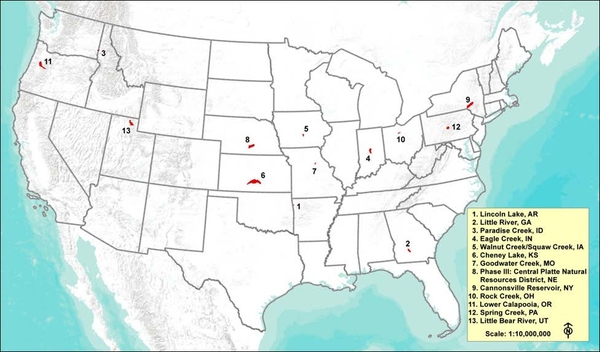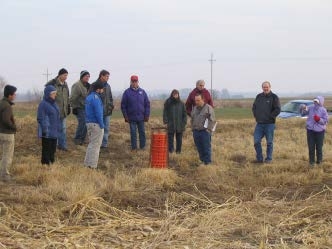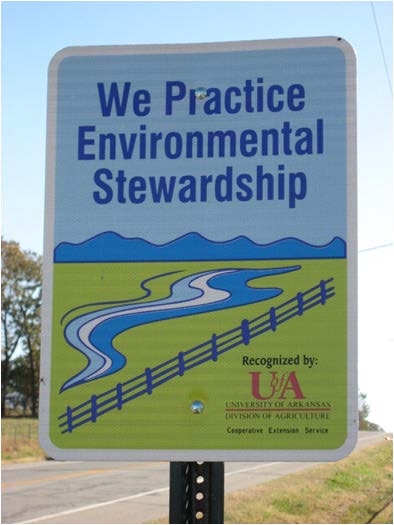NIFA Conservation Effects Assessment Project (CEAP)
Watershed Assessment Studies
Lessons Learned from the National Institute of Food and Agriculture (NIFA)-CEAP Synthesis Fact Sheet 4
Thirteen agricultural watershed projects were funded jointly by the USDA National Institute of Food and Agriculture (NIFA) and Natural Resources Conservation Service (NRCS) to evaluate the effects of cropland and pastureland conservation practices on spatial and temporal trends in water quality at the watershed scale. In some projects, participants also investigated how social and economic factors influence implementation and maintenance of practices. The 13 projects were conducted from 2004 to 2011 as part of the overall Conservation Effects Assessment Project (CEAP). The NIFA-CEAP projects were mainly retrospective; most conservation practices and water quality monitoring efforts were implemented through programs that occurred before the NIFA-CEAP projects began. By synthesizing the results of all these NIFA-CEAP projects, we explore lessons learned about the outreach techniques that were most effective for communicating information to different audiences, achieving adoption of practices, and improving management and/or maintenance of practices in different geographic settings.
Funding and Design
The NIFA-CEAP projects were designed to be retrospective and focused on the effects of previously implemented conservation practices on water quality. Outreach activities occurring before project inception often continued during the NIFA-CEAP project; outreach may or may not have been integrated with NIFA-CEAP outreach education activities. One NIFA-CEAP project (Lincoln Lake Watershed, AR) funded education directly through Cooperative Extension. Outreach in the other watersheds was provided by multiple sources: land-grant university extension services, grant programs such as the U.S. Environmental Protection Agency (EPA) Section 319 programs, Soil and Water Conservation Districts (SWCDs), farmer organizations, and various nonprofit groups. In the Kansas and New York projects, farmer-led organizations provided education and promoted conservation practices in association with state and county agencies.
Much of the outreach education programming in the NIFA-CEAP projects was based on providing traditional programs without well-defined, independent goals and objectives for achieving conservation practice adoption. Watershed projects in Lincoln Lake (AR), Cheney Lake (KS), and Cannonsville Reservoir (NY) had good cooperation and impact because there was an outreach plan that included goals, objectives, strategic activities, evaluations, and feedback. Extension programming was integrated with other ongoing efforts, which increased farmer involvement.
Lesson: Conservation outreach programs with clearly stated goals and objectives achieve greater success.
In the Cannonsville Reservoir watershed (NY), many educational tools were used to support implementation of nutrient management plans, and educational efforts were coordinated with financial incentives, such as support to refurbish manure spreaders. Outreach education efforts included manure management calendars, calibration field days, and regular training updates with emphasis on voluntary compliance to avoid regulation. The manure management calendars made it easy for farmers to know when and where to spread manure and how much to spread. Financial support allowed them to maintain spreaders, increasing manure spreading efficiency.
Lesson: Outreach education to promote conservation practice adoption is most effective when focused on the most meaningful issues for farmers: profit, flexibility, and convenience.
Outreach programs must be carefully tailored to the target audience(s); clearly communicate the issues, needs and opportunities; be consistent; and reach the audience. Various combinations of the following outreach education activities were used by the NIFA-CEAP project teams to encourage conservation practice adoption:
- one-on-one farm visits
- group meetings and presentations
- on-farm demonstrations
- field days
- newsletters
- fact sheets
- training and certification
- community networks
- watershed maps
- electronic presentations
Lesson: Multiple outreach education techniques should be used to reach target audiences.
Trust and Cooperation
In Lincoln Lake (AR), a full-time Extension educator funded through the NIFA-CEAP project worked with farmers specifically on nutrient management plans. This person gained the trust of clients through ongoing personal contacts and familiarity with local farming practices. In Indiana, a retired NRCS conservationist was hired using EPA Section 319 funds to promote farm conservation practices for effective nutrient management. Sometimes the best messenger to use is a peer farmer. In Oregon, the local Extension agent used early adopters and their farms as models so neighbors could observe conservation practices on the ground. This approach also was used in Indiana and Arkansas to provide opportunities for “farmer-to-farmer” informal education. In Pennsylvania, the original project leader, a university scientist, worked with farmers one-on-one to help them understand the importance of fencing and stream buffers to maintaining healthy trout streams on their properties. Meeting one-onone with farmers on their properties was very effective in changing behaviors and promoting adoption.
Lesson: Outreach education activities are most effective in promoting conservation practice adoption when conducted one-on-one and coordinated by a trusted, local “point-of-contact” who is experienced with local farming practices and respected by the agricultural community.
There were several examples of farmer-led programs, including the Cannonsville Reservoir (NY), and Cheney Lake (KS) NIFA-CEAP projects. In New York, an agricultural council forged links among farmers, environmental groups, Extension, NRCS, SWCDs, and other organizations. The council trains 25% of the farmers in its watershed each year, and the outreach includes support for technology, education, and funding. Funds for this effort come from New York City. A farmer-led conservation committee in the Cheney Lake (KS) project is funded by the City of Wichita. The committee provides education to farmers (via a farmer-to-farmer program) and determines what conservation practices will be funded and where practices will be placed. Coordination is done through the local SWCD and a paid project manager. These programs effectively rallied Extension, NRCS, and other organizations into a coordinated program. Most areas, however, would have difficulty accomplishing this level of cooperation without additional funds to form a catalyst.
Lesson: Outreach education activities were very effective in promoting conservation practice adoption when organized by the farmers themselves. However, the farmers had support from state and city agencies, and this support required outside financial resources.
Effectiveness was enhanced by interaction with networks of local stakeholders representing target audiences. In Indiana, New York, and Ohio, local watershed stakeholder groups helped guide outreach education activities. These groups included farmers, environmental interest groups, and resource agency professionals with a thorough understanding of the people, farming practices, and water quality issues in the local watersheds. Outreach education programs were tailored to meet local needs based on feedback from these networks. Strong networks provided opportunities for limited-budget outreach education programs to extend their influence. Networking also provided an opportunity to package what each group had to offer in one place. For example, Extension can provide educational assistance, with technical advice being provided by the NRCS or the SWCD and funding for cost-sharing provided by the Farm Service Agency (FSA) or other special funding programs. Finally, coalitions reduce the likelihood of conflicting messages. In one watershed, contradictory claims about water quality problems associated with atrazine were made by university personnel and an advocacy group. Consequently, farmers lost confidence in the outreach message, and participation in the project by farmers decreased.
Lesson: Coalitions working together improve impacts.
Some NIFA-CEAP project teams operated their outreach education programs through nonprofit organizations, such as the South Georgia Regional Development Center, the Eagle Creek Watershed Association, Friends of the Prairie Learning Center—Neal Smith National Wildlife Refuge, and the Sandusky River Watershed Coalition.
Lesson: Nonprofit organizations can provide information, but do not have the structure or resources to change behavior.
Limitations
In the Little Bear River Watershed (UT), 61% of the management practices and 35% of the structural practices were not maintained after the Hydrologic Unit Area (HUA) project was completed. Although various factors affected the abandonment of practices, a key informant survey indicated that lack of follow-up by project staff due to agency policies and resource or personnel limitations played a role.
Lesson: Post-installation outreach, follow-up, and support are important to ensure that practices are implemented, and also to assist farmers with adaptive management to promote long-term sustainability.
Extension and NRCS were active in many of the NIFACEAP watersheds. It was clear, however, that when resources are scarce, outreach networks are likely to be weak. The most frequent sources of information for producers were other farmers or personal research. Some farmers identified Extension as an information source, but others noted that Extension programs have been diluted due to shrinking budgets, working in multiple counties, and tackling too many topics. In only two locations did farmers rank Extension as extremely important in increasing conservation practice adoption: New York and Arkansas. And in both these watersheds, additional funding was provided expressly to Extension. Farmers noted some of the same problems with NRCS; technical assistance was in decline.
Lesson: Traditional agricultural support agencies are losing credibility with farmers. In an era of diminishing public resources, Extension, NRCS, and state conservation agencies must reassess and determine how to work together more effectively to package, market, and deliver critical education and technical assistance to agricultural producers.
In the Little Bear River watershed (UT), a prior HUA program conducted an extensive outreach effort from 1992 through 1997 targeting six audiences: landowners, the general public, public schools, civic groups, Utah State University Extension personnel, and others. Extension personnel made more than 100 visits per year in the watershed. Extension used newsletters, field trips, workshops, seminars, and landowner visits to reach watershed residents. The NIFA-CEAP project team evaluated the impact of the HUA program on farmers. Farmers did understand that a water quality problem existed and that the program was trying to improve water quality. Three primary reasons, however, that farmers participated in the project were cost sharing, interest for the HUA, and desire to improve farm operations; thus, NRCS had the greatest effect on farmer participation. A few projects, however, clearly demonstrated behavior change (conservation practice adoption) through NIFA-CEAP project activities (e.g., Arkansas). Many other projects demonstrated changes in conservation implementation, but these changes occurred over a long period (up to 30 years) and involved multiple agencies, changes in production technologies, and other factors.
Lesson: Education and behavior change should not be confused. Education alone was rarely sufficient to promote behavior change (conservation practice adoption), and regulation was used in some cases.
Related Resources
Devlin, D. and L. French. 2011. Cheney Lake Watershed: Local Leadership: Goals and Actions. Publication MF3034. Manhattan, KS: Kansas State University Agricultural Experiment Station and Cooperative Extension Service.
Gale, J. A., D. E. Line, D. L. Osmond, S. W. Coffey, J. Spooner, J. A. Arnold, T. J. Hoban, and R. C. Wimberley. 1995. The Role of Information and Education in Agricultural Nonpoint Source Pollution Control Projects: The Rural Clean Water Program Experience. Raleigh: NC State University Water Quality Group.
Osmond, D., D. Meals, D. Hoag, and M. Arabi (eds). 2012. How to Build Better Agricultural Conservation Programs to Protect Water Quality: The National Institute of Food and Agriculture Conservation Effects Assessment Project Experience. Ankeny, IA: Soil and Water Conservation Society.
Information
For more information about the NIFA-CEAP Synthesis, contact Deanna Osmond, NC State University.
Acknowledgments
The authors are grateful for the funding supplied by the USDA National Institute of Food and Agriculture (NIFA) and Natural Resources Conservation Service (NRCS) (Agreement No. 2007- 51130-18575). We want to thank all NIFA-CEAP project personnel for their help with this publication, our site visits, and our information-gathering efforts. In addition, we greatly appreciate all the time spent by key informants during our interviews with them. We also wish to thank the USDA CEAP Steering Committee and USDA NIFA Committee for Shared Leadership for Water Quality for their comments, questions, and advice during this synthesis project, as well as a special thanks to Lisa Duriancik of NRCS.
This material is based upon work supported in part by the National Institute of Food and Agriculture and the Natural Resources Conservation Service, U.S. Department of Agriculture, under Agreement No. 2007-51130- 18575. Any opinions, findings, conclusions, or recommendations expressed in this publication are those of the author(s) and do not necessarily reflect the view of the U.S. Department of Agriculture. USDA is an equal opportunity provider and employer.
Prepared By
Greg D. Jennings, NC State University
Dana LK. Hoag, Colorado State University
Mark L. McFarland, Texas A&M University
Deanna L. Osmond, NC State University
Citation
Jennings, G. D., D. Hoag, M. L. McFarland, and D. L. Osmond. 2012. Lessons Learned from the NIFA-CEAP: Effective Education to Promote Conservation Practice Adoption. NC State University, Raleigh, NC.
Publication date: Jan. 1, 2012
Reviewed/Revised: Jan. 4, 2024
N.C. Cooperative Extension prohibits discrimination and harassment regardless of age, color, disability, family and marital status, gender identity, national origin, political beliefs, race, religion, sex (including pregnancy), sexual orientation and veteran status.





